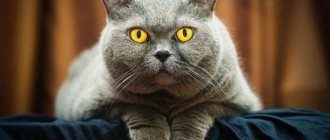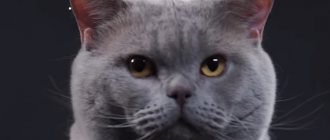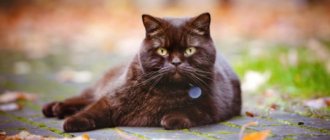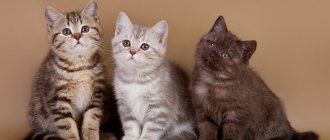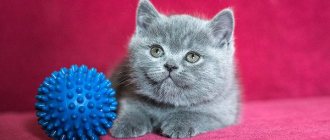The breed of exotic shorthair cats was developed in America in the second half of the 20th century . Cat lover and cattery owner Carolyn Basi crossed a Persian with a shorthaired Burmese to create a brown Persian cat. At the same time, several other nurseries crossed Persians with their short-haired counterparts to obtain a silvery coat. The kittens were born very similar to the Persian, but at the same time had short, thick hair .
Description of the British Shorthair cat breed
The size of an adult British Shorthair cat is rather average, but due to its strong muscular body this stocky animal does not look small. The large round head gives solidity to the dimensions. The muzzle is not too elongated, but also not flattened, like that of the Persians. Cats' faces appear rounder than cats', due to their thick, fluffy cheeks. Many British dogs have a fatty fold on their stomach, but this is not a sign of excess weight - it is an anatomical feature of the breed. The paws are thick, strong, and of medium length. The eyes are large and round, often amber in color, but depends on the color. The tail is of medium length, thick, rounded at the end.
The current breed standard sets the following parameters for a proper Briton.
- Weight. 4-8 kg.
- Height at the withers. It is not measured at shows; it must be based on the age and weight of the animal. Often, British cats are 4-6 cm taller than cats.
- Color. The standard allows about 60 variations. Solid colors of the British Shorthair cat are considered classic.
- Lifespan. 14-16 years old.
- Character. This is a balanced, independent, stubborn, but friendly pet. They know how to truly be friends with a person, but they will not panic every morning when you leave for work and fly headlong to you upon your return. I don’t mind playing or sitting on the couch together, but only when they want to. British cats are intelligent, tactful and require the same attitude.
- Intelligence. The British are smart, aristocratic and artistic when it comes to convincing the owner of the need for urgent feeding. But this is not a breed with which you can perform in the circus or at least delight your family with simple tricks. They learn well the rules of life in the home and adapt to the habits and schedule of the family. Many owners claim that their cats understand human speech well and have a good memory, but the British themselves consider further “education” a waste of their precious time and rarely agree to “training.”
Coat is one of the characteristics of the British Shorthair cat breed. The undercoat and guard hair are almost equal in length, creating the signature plush effect. The coat should be short, thick and loosely adjacent to the body.
Pet colors
Despite the variety of colors allowed by the standard, a number of the most popular ones stand out among them.
- Blue and purple. The main color is grey. For blue ones it is rich, for lilac ones it is silvery, with an admixture of pink or peach.
- Black and chocolate. Their undercoat may be lighter, but it does not affect the overall perception of color.
- White. Can be bright white or light (beige, cream). The undercoat is also light.
Single-color cats of red shades are rare in the breed. But these tones are not uncommon in various color combinations.
- Tortoiseshell. Often a combination of black and red, often with an admixture of white.
- Tabby. The animal's fur has a clearly visible pattern - stripes on its back, a ring on its tail and the letter M on its forehead. Based on the type of pattern, spotted, brindle, and marbled tabbies are distinguished.
- Chinchilla. It looks like a light gray or smoky color, but it is not the full pigmentation of the guard hair that creates it.
The correct definition of the much publicized "whiskas color" is brindle tabby or "black and silver mackerel."
Advantages and disadvantages
The independent character of the British is not as simple as it seems. The table contains the main advantages and disadvantages of this breed.
Table - Pros and cons of the British
| pros | Minuses |
| — Healthy breed; - smart; - clean; - unpretentious in food; - tolerate loneliness well | - Heavy shedding; - are taught only minimal skills; — emotionally little dependent on the owner; - unaffectionate and do not like children; — minimize tactile contacts; - gluttons |
Origin history and interesting facts
The British Shorthair cat breed is considered one of the most natural, that is, scientists do not know when exactly they appeared, and human intervention in their breeding was minimal. It is believed that the ancestors of the British were brought to the islands by the ancient Romans. Since then, the cats have acquired thick, dense fur coats that protect them from the chilly climate of Foggy Albion, and have perfectly mastered hunting rodents, for which they were especially valued by the local population.
Somewhere around the 16th century, people took notice of the beauty of these pets, and some British cats moved from hunting status among the peasantry to the noble class. The official history of the British Shorthair breed began only at the end of the 19th century, when the British, along with other breeds, participated in the first cat show in London.
The 20th century turned out to be difficult for many breeding breeds of animals in Europe. After two world wars, the British population had to be restored with the help of other breeds that were similar in appearance. But in general, the British have survived to this day almost the same as they were 300-500 years ago. Perhaps the status of a popular pet affected the legendary hunting instincts. Modern purebred cats don’t even think about mice, although there are exceptions.
This cat is not only a shining example of a reserved British character, but also a hero of purely English literature. It is believed that it was from the British that Lewis Carroll “copied” his magical Cheshire cat.
Character
These are very gentle, sweet creatures . They don’t raise their voices without a reason, but when they want something, they can be heard very well. Compared to their ancestors, the Persians, they are more energetic and love outdoor games. Exotics are very smart, not at all aggressive . They allow children to play with them, but only one family member is considered the owner. They hate loneliness and get along well with other animals in the house .
Important! Exotics are very vulnerable. Appreciate their love, caress and play with them more often. Cats get sick from lack of attention.
Varieties
Felinological organizations (international professional associations of breeders of purebred cats) in the description of the British Shorthair cat breed distinguish only two varieties.
- Main shorthair line. This standard is described in detail above.
- Longhaired British cat (British Highland). The gene for long hair is found in some breed lines as a result of crosses between Britons and other breeds. Before the British Longhair was recognized as a separate subspecies, such kittens were discarded.
Ordinary people sometimes confuse British cats with Scots and even report them as “British Fold”, but this does not correspond to breed standards. The British always have erect ears. And Scottish cats, although similar in appearance, are a separate breed.
Kittens
Exotic shorthair kittens are very cute creatures. They adapt well to new conditions and quickly get used to their owners.
Newborn kittens look disheveled and awkward. As they grow, their fur becomes plush and their body takes on regular shapes . In a year they will look like adults.
All kittens are born with the same length of fur, but remember that there is a long-haired kitten in the litter. The tail will help determine which of them inherited the Persian's fur. In longhairs it has long hair and looks like a panicle . The tail of short-haired kittens at 4 weeks is covered with short, thick hair. At 1.5 months, the differences between short-haired and long-haired dogs become more noticeable.
Attention! Training to the toilet and sleeping place is not a problem, the kittens are quite smart.
Requirements for maintenance and nutrition
Before you bring an animal into your apartment, you need to complete a number of measures.
- Create a sleeping place. You can lay down a blanket, buy a special bed or house for the cat. It is not a fact that this place will become a favorite after the animal gets used to it. Many adult cats do not have a favorite place to sleep or sleep with their owner, but the baby will come in handy with his own cozy corner.
- Buy bowls for food and water. The British have a fairly wide muzzle - take this into account when choosing dishes.
- Install the tray. For the first time, it is better to take the same litter as the breeder had, later you can try to experiment and choose the one that the cat likes best and will be less likely to be carried around the apartment on its paws.
- Get a scratching post. If your pet doesn’t walk outside, your pet’s claws will still have to be trimmed, but a scratching post will help you preserve your furniture.
- Buy toys. Kittens are much more active than adult animals. Toys will direct this activity in a “peaceful direction” and distract from unwanted behavior.
Hygiene
The British Shorthair's independent character, unpretentiousness in everyday life and natural cleanliness make it an optimal pet for busy people.
- Combing. Performed once a week, and daily during the molting period. Use a metal brush with rounded teeth or a rubber slicker brush to brush through the wool. Cats living in an apartment can shed much longer and more heavily than those that spend a lot of time outside.
- A haircut. This procedure is carried out by a professional groomer - you can ruin the animal’s coat yourself. The use of medications for sedation before the procedure is unacceptable. In addition to aesthetic purposes, Britons are often cut to prevent overheating in hot weather or to minimize hair loss in the home. Frequency is optional.
- Bathing. No more than twice a year or as necessary. Water temperature about 30°C, shampoo for short-haired breeds and taking into account color. After bathing, dry the coat and undercoat well. Animals participating in exhibitions are bathed more often, but not more than once every two months.
- Claw care. Nail trimming is carried out once every two to three weeks with a special pruning shears close to the base, so as not to touch the blood vessels.
- Ear cleaning. Once every two to three weeks. This is done with a cotton swab (a swab can damage the ear). There should be no purulent discharge with a characteristic odor in the cat's ears.
- Treatment for worms. Shown twice a year. Free-range cats are wormed more often.
- Flea treatment. It is held at the beginning of the warm season. For the period of protective action of the insecticide, see the instructions. After its expiration, the animal must be treated again.
Diet
The British have an excellent appetite and are prone to gaining excess weight, so you should feed your British Shorthair cat in portions according to the age and weight of the pet.
A cat’s diet can be based on both dry food and natural products. If you decide to cook yourself, please note that the food should always be fresh and the bowl should be washed after each feeding.
Cats are predators, so the basis of their diet is meat, offal (kidneys, heart, lungs, liver), and fish. The meat should not be fatty; beef and lamb work well. To prevent infection with worms, the product is either boiled or pre-frozen for two days and then given in its thawed raw form. Offal and fish - only in boiled form.
Once a week, cats are given eggs, maybe in the form of an omelette without spices. Milk is given only to kittens; adults replace it with fermented milk products. As a side dish, you can serve vegetable purees (carrots, pumpkin, zucchini) and porridge, but they should take no more than a quarter of the serving. Consult your veterinarian and supplement your natural diet with vitamin and mineral supplements.
Factory food must be at least premium. Some manufacturing companies produce special series for the British and Scots, which optimally take into account the physiological needs of the breed.
Cheap food can cause a cat to develop food allergies, and its fur will fade and begin to fall out. Problems with the digestive system may also occur.
Reproduction issues
Decide in advance whether you want offspring from your future pet. If not, then the best solution is to spay or neuter the animal at a young age. This may seem cruel, but in fact it is humane both for the animal and for you. The reproductive instinct in males and females manifests itself in different ways, but hysterics, spoiled character, vandalism in the apartment and odorous marks everywhere will definitely not make you happy. A pet that has not known the joys of love is calmer, it does not have a sexual instinct that draws them out of the window to exploits, and there is less risk of diseases of the reproductive system. Statistically, neutered cats live longer.
Cats are castrated at the age of about a year, when the genitourinary system is formed, and the operation will not harm other functions. Cats are also sterilized for about a year. It is considered optimal if the operation is performed before the first heat, but not earlier than seven to eight months, so that the body has time to get stronger and tolerate anesthesia and surgery normally.
If you intend to participate in the breeding of purebred British dogs, then this will require a lot of time and effort, as well as investments in the appearance of the pet and its exhibition career, and the hassle of organizing matings. Cat owners should be mentally prepared for the fact that responsibility for the course of pregnancy and childbirth lies with them. In one lambing, a British female can produce up to eight kittens, although the average litter is four to five.
Myths “about love”
There are many misconceptions in the world about spaying and castration of animals.
- A castrated cat is not a cat. The operation will not affect the cat's sexual behavior. It’s just that your pet will never run away in search of a female, will not be left without an eye in a fight for the neighbor’s cat, and will not scream in a bad voice in the middle of the night.
- Only a cat that has given birth can be sterilized. An anti-scientific myth that will only harm the animal. The older the cat, the more difficult it is for her to undergo surgery and recover from anesthesia. Many cats have a strong parental instinct, and once she has nursed kittens, she will demand repetition.
- Obesity from hormones. The pet's weight must be controlled in any case.
"Gentleman's set" of education
Cats in general are animals that are practically impossible to train. You may be lucky and your pet will turn out to be trainable, but often the owner’s tasks in education come down to a few key points.
- Train to the tray. Kittens learn this skill with their mother, but in a new home the baby may become confused. You and your kitten can take a little bit of litter from the breeder's litter box so that the new litter box has a familiar smell. In the first days, the pet is closely monitored, and as soon as it begins to worry and look for something in the corners, it is immediately taken to the tray. You can’t scold your baby too much for puddles and piles, but you shouldn’t make any concessions either. Usually the kitten gets used to the litter box within the first couple of weeks.
- Prohibit stealing from the table. Human food is harmful to animals - it contains a lot of spices and substances harmful to the cat’s body. Stealing your food or begging will disrupt your pet's feeding schedule and unbalance your pet's diet.
- Teach not to tear up furniture (wallpaper, curtains, household clothes). Adult cats scratch objects precisely in order to sharpen their claws, and with proper upbringing, a scratching post is enough for them. For a kitten, the entire world around them is a toy, but their sharp claws can damage or destroy furniture and wardrobe items. If the kitten tries to sharpen its claws on furniture or a wall, take it to the scratching post. Distract your baby from unwanted goals with toys.
Care
The American Shorthair gave the exotics excellent health , but the Persians slightly corrected it, passing on their weak physical aspects.
These are watery eyes, snoring during sleep due to a flattened nose, and deformed teeth. Breeders of these animals say that these cats are for the lazy . They require virtually no maintenance. But some procedures will still have to be carried out daily or several times a month:
- Rinse eyes daily.
- Bathing . No more than once a quarter. During the molting period, 1-2 times a month.
- Trimming nails . Purchasing a claw point will make this task easier.
- Combing . You need to scratch your cat once a week. Exotic wool is prone to matting and requires regular careful grooming.
- It is necessary to dry the animal after bathing . The undercoat takes a long time to dry, and the animal may catch a cold.
- to remove worms from short-haired exotics regularly, once every three months.
Important! Proper feeding of the animal will ensure it has beautiful fur and no health problems. It is not recommended to feed exotics with human food.
Diseases and treatment
On average, the British Shorthair cat lives about 16 years, but many cats live up to 20. This is a hardy, healthy breed, practically free of hereditary diseases.
Vaccinations will protect your pet from major infectious diseases: rhinotracheitis, panleukopenia, calcivirosis, chlamydia and rabies. The first vaccination is carried out at two and a half to three months, a month later - revaccination and rabies vaccination. Then - after two years.
Britons are prone to obesity, which can lead to problems with the cardiovascular system and gastrointestinal tract. They may have dental problems, so check your pet's mouth periodically. A Briton can also catch a cold from a draft or air conditioning, so when taking care of a comfortable temperature for your cat in the summer, don’t overdo it.
Many owners believe that animals that do not leave the apartment do not need vaccinations. This is mistake! You can bring an infection or virus on your clothes and hands, or it can get into your home with a flea or other parasite. Vaccination is required for all cats.
TOP nicknames
British shorthair cats are smart, respectable and impressive. They are rarely called funny names, although diminutive nicknames are ideal for these fatties.
You can call a British Shorthair cat “boy”:
- August;
- Baron;
- Behemoth (black cat based on Bulgakov)
- Cheshire;
- Boston;
- Elvis;
- Newton;
- Al Pacino;
- Windsor;
- Marseilles.
Name the British Shorthair cat “girl”:
- Whiskey;
- Victoria;
- Lexi;
- Zhanna;
- Chelsea;
- Candy;
- Miranda;
- Stella;
- Marquise;
- Tiffany.
Photo review
Photos of British Shorthair cats can be viewed endlessly. The plush fur coat touches with signature creases, the round face suits all kinds of fashionable accessories, and the majestic posture and natural grace decorate any interior.
Cost and where to buy
It is not so easy to accurately answer the question of how much a British Shorthair kitten costs. Due to the popularity of the breed, there is a very wide range of prices in open sources. Moscow nurseries offer kittens from 6 to 30 thousand rubles (data as of January 2018). The cost of a kitten depends on the pedigree, titles of the parents and the exhibition prospects of the pet. A baby classified by experts as show class can cost over 60 thousand rubles.
Choosing a kitten
The British are popular all over the world, which, on the one hand, makes the search for a future pet simple, on the other hand, increases the risk of acquiring an animal with an obscure pedigree and unstable health. To buy a British dog, contact breeders who specialize in this breed.
A kitten is usually taken from its mother at two and a half to three months. He should already have his own veterinary passport with the first vaccination, as well as documents confirming his pedigree.
Ask the breeder about the health of the parents. Before you move on to choosing a baby, look at the mother - she should be calm, clean, well-groomed.
Already at a young age, the body of a Briton must correspond to the proportions determined by the breed standard. The baby's fur is not yet the same as that of an adult, but it is already plush and very soft to the touch. The kitten must be well-fed, clean, ears and eyes without traces of discharge, and a soft tummy. He should show curiosity towards the stranger, and actively play with his brothers and sisters, without timidity or aggression.
Nurseries
You can find nurseries of the British Shorthair breed in almost every region of Russia and neighboring countries. Here are some of them:
- ROYAL MOORE (Moscow) - https://royalmoore.ru/;
- FANCY BOX (Moscow and Krasnodar) - https://mystic-cats.ru;
- “Cheshire cats” (Samara) - https://cheshirskycats.ru;
- GREEN LAKE (Sverdlovsk region) - https://britishcat666.ru;
- Elite British (Minsk) - https://elite-british.by.
The British are real aristocrats who demand respect from the owner rather than fuss and hassle with care and maintenance. Reviews of the owners about the British Shorthair cat will help you decide whether this affectionate but independent animal is right for you.
Video on the topic: A story about the British Shorthair cat
Health
We have already said that exotics inherited a tendency to disease from the Persians. To help a cat cope with the consequences of crossing, it is necessary to carry out a number of care procedures :
- Remove discharge from the corners of the eyes. If lacrimation is profuse, perform the procedure several times a day.
- Gingivitis is an inflammation of the oral tissues that leads to tooth loss. Consult your veterinarian and select a toothpaste for your cat. Use your own finger wrapped in gauze instead of brushes for cleaning. Preventive measures will relieve the animal of stone, plaque and toothache.
- After reaching the age of 5-6 years, many representatives of shorthaired exotics experience changes in kidney and liver tissue. These are harbingers of a serious illness. Polycystic kidney disease has no cure. But preventive measures can reduce the risk of disease and slow the progression of the disease.
- Another feature of exotics is a predisposition to heart disease. Most often, the tissue of the heart ventricle thickens. Cats get sick in adulthood. It is impossible to determine the disease by external signs.
Important! Owners of exotic animals do not need to worry that their pet will definitely inherit all these diseases. But you should be careful about your cat’s health, provide it with the necessary care and proper nutrition, then the risk of disease can be reduced to a minimum.

